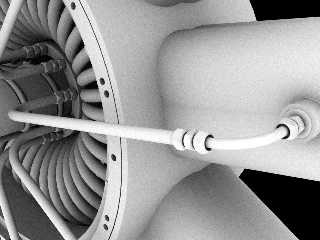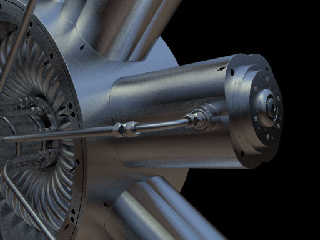 |
 |
|
 |
|
 |
|  |
|  |
|
 |
|
 |
|  |
|  |
|
 |
"H. Karsten" <h-karsten()web.de> wrote:
> And one more detailed
>
> Holger
This is beautiful & coming along quickly. Just curious - are you modeling in
SDL or what approach are you taking?
Charles
Post a reply to this message
|
 |
|  |
|  |
|
 |
|
 |
|  |
|  |
|
 |
Charles C wrote:
> Stephen <mca### [at] aolDOT com> wrote:
>
>> Yes there are but you would only use them for straight runs or ones with
>> you would use a compression fitting.
>
> I've seen it where pipe thread was used -and- the rotation/orientation mattered.
> Charles
>
I bet who ever did it had no intention of doing maintenance on it.
Cheapskate! ;)
--
Best Regards,
Stephen com> wrote:
>
>> Yes there are but you would only use them for straight runs or ones with
>> you would use a compression fitting.
>
> I've seen it where pipe thread was used -and- the rotation/orientation mattered.
> Charles
>
I bet who ever did it had no intention of doing maintenance on it.
Cheapskate! ;)
--
Best Regards,
Stephen
Post a reply to this message
|
 |
|  |
|  |
|
 |
|
 |
|  |
|  |
|
 |
"Charles C" <nomail@nomail> wrote:
....
> This is beautiful & coming along quickly. Just curious - are you modeling in
> SDL or what approach are you taking?
> Charles
Thanks :)
I'm using Rhino, export this as pov-code in ten different levels, converting the
lowest detail one in to Raw (using basic) and than to obj, using Deep
Exploration. Than import this into 3DS-Max. Animating the part there and render
a (so called) "vue-file". It contains matrix-transform-data. My Pov-script take
now higher level geometry, using the matrix from MAX and do the rendering.
The matrix-vue-file from MAX is converted, using Basic.
Holger
Post a reply to this message
Attachments:
Download 'hand8.jpg' (66 KB)
Preview of image 'hand8.jpg'

|
 |
|  |
|  |
|
 |
|
 |
|  |
|  |
|
 |
H. Karsten wrote:
> "Charles C" <nomail@nomail> wrote:
> .....
>
>
>> This is beautiful & coming along quickly. Just curious - are you modeling in
>> SDL or what approach are you taking?
>> Charles
>
> Thanks :)
>
>
Swagelok are the fittings of choice for quality and pressure fittings.
IMHO :D
--
Best Regards,
Stephen
Post a reply to this message
|
 |
|  |
|  |
|
 |
|
 |
|  |
|  |
|
 |
Stephen <mca### [at] aolDOT com> wrote:
...
> Swagelok are the fittings of choice for quality and pressure fittings.
> IMHO :D
>
> --
>
> Best Regards,
> Stephen
Hi Stephen,
Sorry, I can not use your fittings. My machine uses Ultra-high-pressure, super
conductive, antimatter plasma-mono-magnetic-fluid.
The colors wound fit ;)
Holger com> wrote:
...
> Swagelok are the fittings of choice for quality and pressure fittings.
> IMHO :D
>
> --
>
> Best Regards,
> Stephen
Hi Stephen,
Sorry, I can not use your fittings. My machine uses Ultra-high-pressure, super
conductive, antimatter plasma-mono-magnetic-fluid.
The colors wound fit ;)
Holger
Post a reply to this message
|
 |
|  |
|  |
|
 |
|
 |
|  |
|  |
|
 |
Hi people
Not very much things added today, just a few peaces, and the fillets.
These little rounding in all corners are *very* important for me. They are the
reason for me, to use a cad-program.
Take a closer look to all thing around you. You'll see, that there is not a
singe real corner. Everything is a little rounded. And if its just a little: the
"corner" will reflect the light different as an "artificial" one. Because of its
round shape, it reflects the light nearly always!
If you are interested in modeling with cad programs, you can use HeeksCAD.
Its free.
http://code.google.com/p/heekscad/issues/detail?id=193
You just have to convert the result to a mesh.
Compare the corners now with the rendering from before.
Holger :)
Post a reply to this message
Attachments:
Download 'hand9.jpg' (32 KB)
Preview of image 'hand9.jpg'

|
 |
|  |
|  |
|
 |
|
 |
|  |
|  |
|
 |
H. Karsten wrote:
> Stephen <mca### [at] aolDOT com> wrote:
> ....
>> Swagelok are the fittings of choice for quality and pressure fittings.
>> IMHO :D
>>
>> --
>>
>> Best Regards,
>> Stephen
>
> Hi Stephen,
>
> Sorry, I can not use your fittings. My machine uses Ultra-high-pressure, super
> conductive, antimatter plasma-mono-magnetic-fluid.
>
Shame :(
> The colors wound fit ;)
>
--
Best Regards,
Stephen com> wrote:
> ....
>> Swagelok are the fittings of choice for quality and pressure fittings.
>> IMHO :D
>>
>> --
>>
>> Best Regards,
>> Stephen
>
> Hi Stephen,
>
> Sorry, I can not use your fittings. My machine uses Ultra-high-pressure, super
> conductive, antimatter plasma-mono-magnetic-fluid.
>
Shame :(
> The colors wound fit ;)
>
--
Best Regards,
Stephen
Post a reply to this message
|
 |
|  |
|  |
|
 |
|
 |
|  |
|  |
|
 |
"H. Karsten" <h-karsten()web.de> wrote:
>
> I'm using Rhino, export this as pov-code in ten different levels, converting the
> lowest detail one in to Raw (using basic) and than to obj, using Deep
> Exploration. Than import this into 3DS-Max. Animating the part there and render
> a (so called) "vue-file". It contains matrix-transform-data. My Pov-script take
> now higher level geometry, using the matrix from MAX and do the rendering.
> The matrix-vue-file from MAX is converted, using Basic.
>
> Holger
Wow, what version of POV-Ray is this from? Or is this a preview from Rhino or
Max? It looks like a Monte Carlo ambient occlusion pass of some sort...
Post a reply to this message
|
 |
|  |
|  |
|
 |
|
 |
|  |
|  |
|
 |
"H. Karsten" <h-karsten()web.de> wrote:
> Hi people
>
> Not very much things added today, just a few peaces, and the fillets.
> These little rounding in all corners are *very* important for me. They are the
> reason for me, to use a cad-program.
>
> Take a closer look to all thing around you. You'll see, that there is not a
> singe real corner. Everything is a little rounded. And if its just a little: the
> "corner" will reflect the light different as an "artificial" one. Because of its
> round shape, it reflects the light nearly always!
>
> If you are interested in modeling with cad programs, you can use HeeksCAD.
> Its free.
>
> http://code.google.com/p/heekscad/issues/detail?id=193
>
> You just have to convert the result to a mesh.
>
> Compare the corners now with the rendering from before.
>
> Holger :)
Yes, bevels make a huge difference in removing that obvious CG-ness from a shot.
This section would look great with a bump map of some anisotropic brushing
running around the circumference of the cylinders. Really nice job so far H.
Post a reply to this message
|
 |
|  |
|  |
|
 |
|
 |
|  |
|  |
|
 |
Robert McGregor schrieb:
> Wow, what version of POV-Ray is this from? Or is this a preview from Rhino or
> Max? It looks like a Monte Carlo ambient occlusion pass of some sort...
Looks like MCPov to me.
Post a reply to this message
|
 |
|  |
|  |
|
 |
|
 |
|  |




![]()